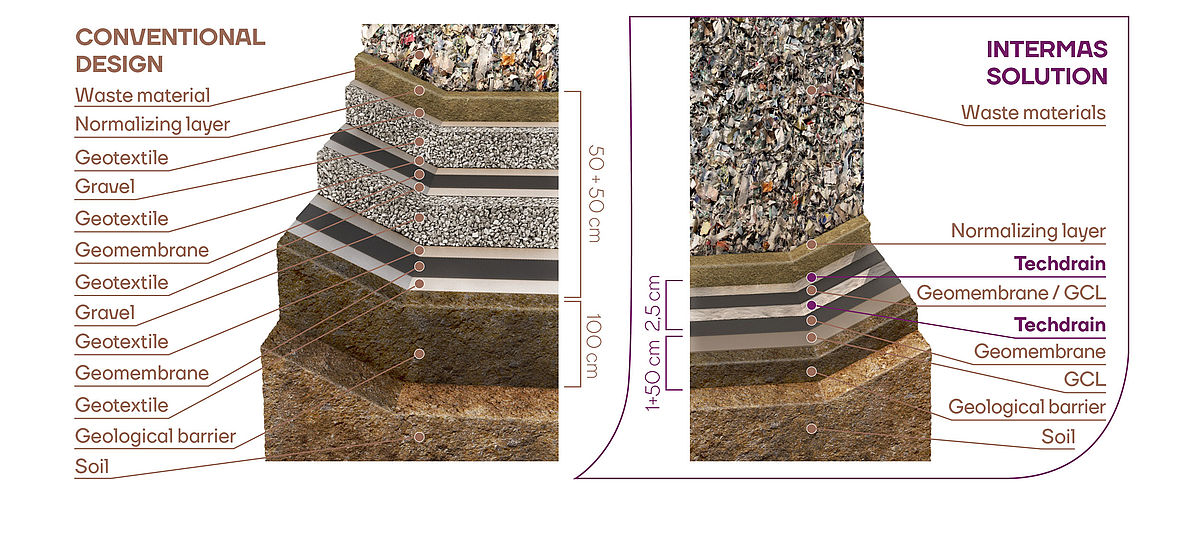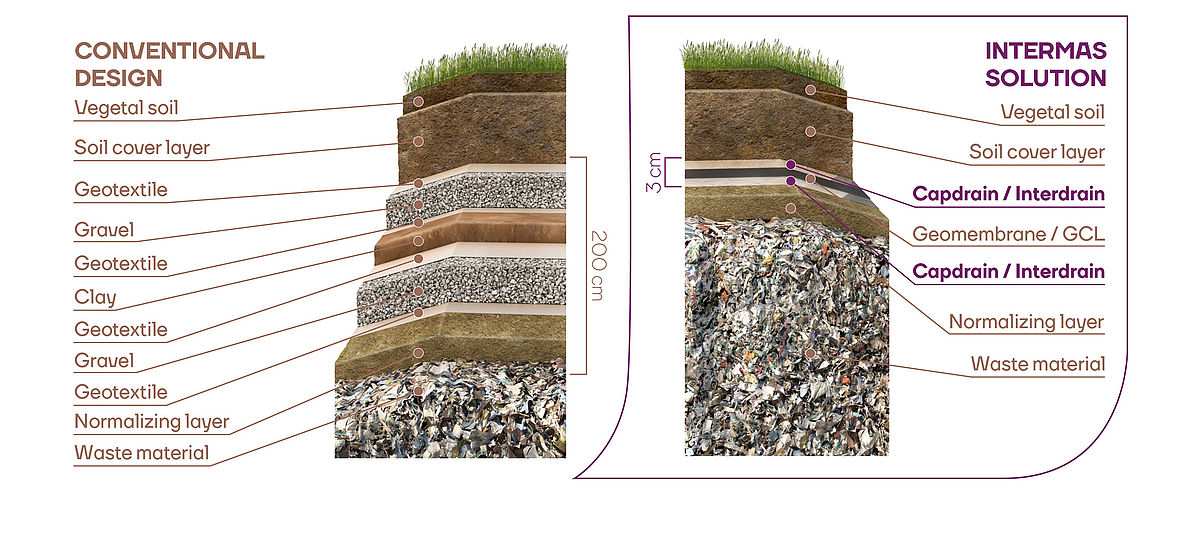TECHDRAIN Landfills
Landfills
Formed by a triplanar HDPE geonet thermally bonded over one or both sides to nonwoven PP geotextiles. Geonets and geocomposites are used for a wide variety of applications covering new cells and closures Rainwater collection layer: Located over the containment liner in caps and closures, drainage geocomposites are used to avoid water pressure buildup in topsoils Biogas collection layer: Located under the containment liner in caps and closures, drainage geocomposites are the most realiable media through which the gases generated inside the waste mass can be collected and displaced towards ventilation shafts Leachate collection layer: Geocomposite drains offer the most reliable system to avoid the accumulation of leachate over the base liner while keeping its structure unsaturated Leak detection layer: Geonet and geocomposite drains are placed in between containment layers to create a void space through which leaking fluids can be detected and displaced outwards
5877Contributions
• Improves the drainage capacity or completely replaces the natural drainage layer • Homogeneous drainage solution that follows strict quality control procedures • Simple and aesthetic design that harmonically complements other geosynthetic systems • Lightweight and flexible composition • Highly robust and resilient, able to withstand the loads applied during installation • Chemically inert and imperishable • Fast, easy and reliable installation, does not require heavy machinery or qualified staff • Outstanding transportation capacity • Easy to store and protected against external agents • Low carbon footprint
Features
• Extremely high transmissivity • Extremely low core compressibility • Stable transmissivity over the long term in accordance with GRI GC13 Specification • Suitable for installation over steep slopes • Customizable geotextiles • Under ISO and ASTM Standards • Rolls up to 4-m wide and customizable length





New cells
Nowadays the raising environmental consciousness made us change the concept of Landfill. It is now impossible to think that a landfill is just a place for storing waste materials.
The modern landfill is a totally waterproofed container, prepared for storing all kinds of inert or dangerous materials, guaranteeing the protection of the environment by:
- a leak detection system of the waterproofing layer.
- drainage and collection of leachates (highly polluting liquids formed by the contact between water and waste materials).
Capping
Once the landfill is used at its full capacity, it must be capped by:
- a waterproofing layer.
- a rain water drainage system.
- a gas collection system.
To avoid the contact between rain water and waste material, as well as the uncontrolled evacuation of the bio-gas into the atmosphere, these systems also reduce the overpressure caused by the water.
TECHDRAIN TECHDRAIN - Landfills
Landfills
Formed by a triplanar HDPE geonet thermally bonded over one or both sides to nonwoven PP geotextiles. Geonets and geocomposites are used for a wide variety of applications covering new cells and closures Rainwater collection layer: Located over the containment liner in caps and closures, drainage geocomposites are used to avoid water pressure buildup in topsoils Biogas collection layer: Located under the containment liner in caps and closures, drainage geocomposites are the most realiable media through which the gases generated inside the waste mass can be collected and displaced towards ventilation shafts Leachate collection layer: Geocomposite drains offer the most reliable system to avoid the accumulation of leachate over the base liner while keeping its structure unsaturated Leak detection layer: Geonet and geocomposite drains are placed in between containment layers to create a void space through which leaking fluids can be detected and displaced outwards
5877Contributions
• Improves the drainage capacity or completely replaces the natural drainage layer • Homogeneous drainage solution that follows strict quality control procedures • Simple and aesthetic design that harmonically complements other geosynthetic systems • Lightweight and flexible composition • Highly robust and resilient, able to withstand the loads applied during installation • Chemically inert and imperishable • Fast, easy and reliable installation, does not require heavy machinery or qualified staff • Outstanding transportation capacity • Easy to store and protected against external agents • Low carbon footprint
Features
• Extremely high transmissivity • Extremely low core compressibility • Stable transmissivity over the long term in accordance with GRI GC13 Specification • Suitable for installation over steep slopes • Customizable geotextiles • Under ISO and ASTM Standards • Rolls up to 4-m wide and customizable length





Gran Canarias’s (Spain) Juan El Grande landfill capping
Products and quantities installed:
Capdrain 55.12: 210000 m2
Interdrain GXG 412: 210000 m2
Do you have a project in geosynthetic?
We encourage you to discuss your specific needs with our technical sales team which will be pleased to help you find the optimal solution to your needs.
Our catalog for Geosynthetic



